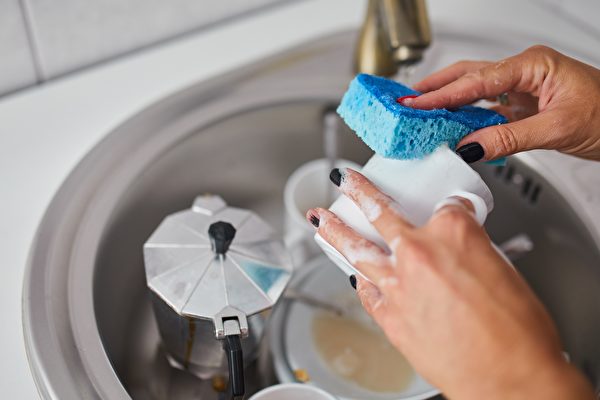Washing dishes is a seemingly simple yet essential household chore. Whether hand washing or using a dishwasher, undoubtedly, everyone wants to ensure their tableware is thoroughly cleaned. However, many people often unconsciously make some mistakes in practice, leading to potential health hazards. Cleaning experts have listed ten things you should not do when washing dishes, so let’s check how many you are doing correctly.
When hand washing dishes, using a clean sponge is crucial. Bree Lemmen, kitchen brand manager at Whirlpool, said, “A dirty sponge can breed bacteria and produce odors. If not cleaned properly, it may spread bacteria and odors to the dishes.”
“It’s best to clean the sponge every few days and replace it every one to two weeks,” Lemmen said.
Kathy Cohoon, Director of Franchise Operations at the household cleaning franchise “Two Maids,” said that using too much detergent can not only cause wastage but may also leave residues or films on the dishes. For most detergent brands and formulas, you only need a few drops to wash a pile of dishes. Overusing detergent usually does not damage dishes but increases the workload because you will eventually have to clean the residues of the detergent.
Cohoon said that detergents used for hand washing dishes and dishwasher detergents should not be switched, as they are specifically designed for their respective cleaning tasks.
Using dishwasher detergent while hand washing dishes can potentially damage the skin and the dishes because dishwasher detergents have higher concentrations and different active ingredients. On the other hand, using hand dishwashing detergents in a dishwasher can damage the machine and cause excessive foaming inside.
Timely dish cleaning helps maintain the kitchen’s optimal appearance and smell. Cohoon said that allowing dishes or food residues to accumulate in the sink can cause odors in the kitchen and may affect the drainage system.
For greasy dishes, wiping off the oil residues with kitchen paper before washing can make the dishwashing process easier and prevent oil stains from causing pipe blockages.
Believe it or not, there’s no need to rinse dishes before putting them in the dishwasher.
“Dishwasher detergents are designed specifically to tackle food particles left on dishes, so pre-rinsing dishes actually inhibits the detergent’s effectiveness,” Lemmen said.
According to Cohoon, washing dishes in an unclean sink increases the workload and can lead to cross-contamination and bacteria affecting clean dishes. Therefore, it is best to wash dishes in a clean area for the best results and hygiene.
Similarly, avoid washing dishes in a dirty dishwasher. Lemmen said that regular cleaning of the dishwasher can prevent odors, detergent, and food residue build-up, as these factors can affect the dishwasher’s cleaning effectiveness over time.
Lemmen advised not to overcrowd the dishwasher, as it affects the cleanliness of the dishes and can damage the machine. She further explained that when dishes are too close together or loaded improperly, they cannot be properly cleaned because the spray and detergent may not reach every surface. Overloading the dishwasher can also trap or block the spray arms.
Choosing the right water temperature when washing dishes ensures proper cleaning and is also essential for safety reasons.
“Using water that is too hot can harm the hands, even cause burns,” Cohoon said. “Using water that is too cold may not easily remove dirt; you may need to exert more effort to make the dishes shine.”
If washing dishes in a dishwasher, the ideal water temperature is 120 degrees Fahrenheit.
Before storing dishes, make sure they are dry. Cohoon said that when there is moisture on the dishes, they must be wiped dry before storing. Storing damp dishes in cabinets can lead to mold growth and potentially damage the cabinet’s interior.
It is suggested that chopsticks should be placed to dry with the tips facing upward after washing, as the bottom of the chopstick holder is harder to clean and may harbor some residual moisture that can promote bacteria growth.
Understand which items can be put in the dishwasher and which cannot to avoid potential accidents. Some materials and fragile items should be hand-washed as they may be damaged by detergent or the high temperature of the dishwasher.

